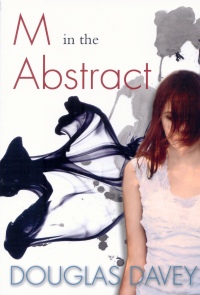| ________________
CM . . . . Volume XIX Number 35 . . . . May 10, 2013
excerpt:
Douglas Davey's first book, M in the Abstract, provides readers with a lesson on symbolism through the story of teenager Mary's inner turmoil and the "shadows" that haunt her life. Mary (Mariposa, or "M" in the title) wants to hide from the world. She is in constant conflict with her mother's concerned attempts to force Mary out of her shell, and she obsessively yearns for her father who she hasn't heard from since she was five or six-years-old. To add to Mary's problems, she is haunted by dark figures she refers to as shadows. Mary fears other people will discover the predominantly sinister and uncontrollable shadows. The shadows have been a threatening presence in Mary's life in the 10 years since her father left, but she is unsure whether or not the shadows are hallucinations and where they come from. In general, the strength of M in the Abstract comes from Davey's refusal to fully answer all of the reader's questions, including questions about Mary's mental state, why her dad left, and where he is now. These ambiguities add depth and may keep readers engaged as they want to uncover the truth about Mary's strange experiences and atypical behaviour. However, the ambiguities may also serve to alienate some readers from Mary as they are constantly shut out as to what really lies behind her often-irritating angst-filled behaviour. Conversely, although ambiguity is often a strength of the novel, there are also instances where story becomes patronizingly didactic because it seems the author does not trust the adolescent reader to make sense of events without repeated not-so-subtle hints in literary analysis. This is most obtrusive in scenes with Mary's English teacher, Mr. Woods. It appears Mr. Woods was created as a tool to inform the reader that Mariposa means butterfly, to lecture the reader on symbolism, and to explain how the butterfly lifecycle can symbolize change. It seems the author believes readers have to be explicitly taught this information in order to make sense of what is happening when Mary turns her wormy shadows into butterfly wings and emerges "as a new person" at the end of the story. For a book replete in ambiguity, obvious attempts to point out literary devices make the novel feel as if it was written teach literary analysis in high school classrooms rather than stand on its own as a work of literature. Readers looking for something different in Young Adult fiction may enjoy the self-conscious play with literary complexity that is prominent in M in the Abstract. Recommended. Beth Wilcox, a graduate from the MA in Children's Literature program at the University of British Columbia, is currently teaching in Prince George, BC.
To comment
on this title or this review, send mail to cm@umanitoba.ca.
Copyright © the Manitoba Library Association. Reproduction for personal
use is permitted only if this copyright notice is maintained. Any
other reproduction is prohibited without permission.
NEXT REVIEW |
TABLE OF CONTENTS FOR THIS ISSUE
- May 10, 2013.
AUTHORS |
TITLES |
MEDIA REVIEWS |
PROFILES |
BACK ISSUES |
SEARCH |
CMARCHIVE |
HOME |
